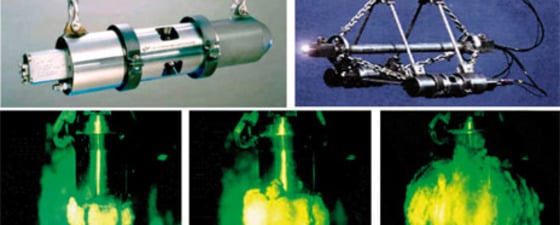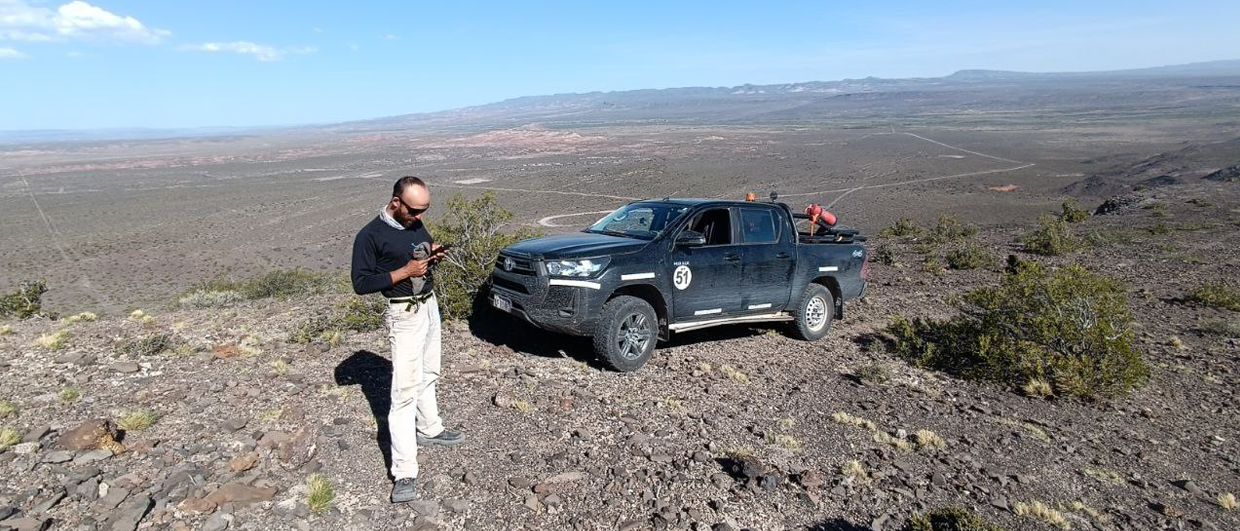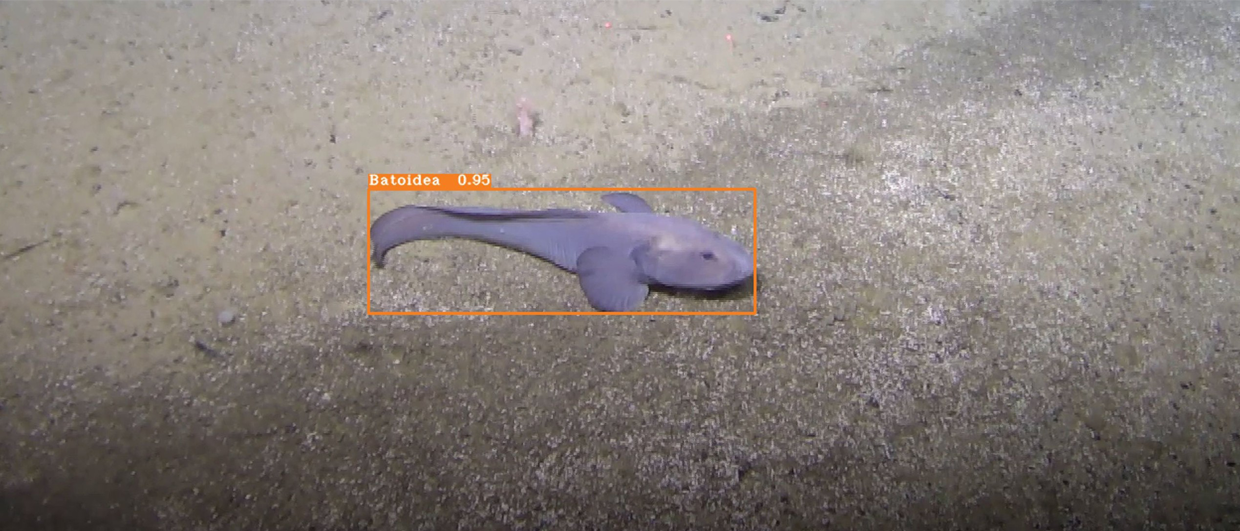A seismic source is defined as any device which releases energy into the earth in the form of seismic waves. The major source type in marine exploration is the air-gun array, which since the 1970’s has been by far the most popular. The air-gun can be described as a chamber of compressed air that is released rapidly into the surrounding water to create an acoustic pulse. The air gun is the most commonly used source because the pulses are predictable, repeatable and controllable, it uses compressed air which is cheap and readily available, and it has only a minor impact on marine life.
Size and geometry
 Top: Single air-gun and three-gun cluster (www. bolt-technology.com). Bottom: Pictures of air bubbles 1 ms, 1.5 ms, and 7 ms after firing a small air-gun in a tank (Langhammer 1994).An air-gun volume is measured in litres (l) or more commonly, by the conservative petroleum geophysicist, in cubic inches (in3). Typical volumes of individual air-guns used by the exploration industry vary from 20 in3 (0.3 l) to 800 in3 (13.1 l), while academic seismic refraction studies can use volumes up to 1600 in3 (26.2 l). An air-gun array consists of 3 – 6 sub-arrays called strings, each string containing 6 – 8 individual guns, so that the array usually involves between 18 and 48 guns, although in special cases as many as 100 guns an array can be used. The air-gun array volume is the sum of the volumes of each gun, and is typically in the range 3,000-8,000 in3 (49.2-131.6 l).
Top: Single air-gun and three-gun cluster (www. bolt-technology.com). Bottom: Pictures of air bubbles 1 ms, 1.5 ms, and 7 ms after firing a small air-gun in a tank (Langhammer 1994).An air-gun volume is measured in litres (l) or more commonly, by the conservative petroleum geophysicist, in cubic inches (in3). Typical volumes of individual air-guns used by the exploration industry vary from 20 in3 (0.3 l) to 800 in3 (13.1 l), while academic seismic refraction studies can use volumes up to 1600 in3 (26.2 l). An air-gun array consists of 3 – 6 sub-arrays called strings, each string containing 6 – 8 individual guns, so that the array usually involves between 18 and 48 guns, although in special cases as many as 100 guns an array can be used. The air-gun array volume is the sum of the volumes of each gun, and is typically in the range 3,000-8,000 in3 (49.2-131.6 l).
The air-guns hang in the sea beneath floats between 3m and 10m below the sea surface, generally at about 6m, except for refraction studies when a deeper deployment is needed. The gun pressure mostly used by the seismic industry is 2,000 psi (138 bar) and during a survey, the guns fire every 10-15 seconds.
It is common to arrange several (2-4) air-guns in a cluster, with the guns so close together that they behave as a larger single gun. The main purpose of clustering is to improve signal characteristics, since the bubble motion (see below) is reduced by this configuration.
The energy sent out by air-gun arrays is dominantly directed vertically downwards. The broad band of frequencies from the array form a pulse with peak-to-peak amplitude in the range 14-28 bar-m, corresponding to 243-249 dB re 1 mPa-m vertically downward. The amplitude levels emitted horizontally tend to be 15-24 dB lower. These numbers are frequency dependent. By filtering out high frequencies there is less deviation between amplitude levels vertically and horizontally.
Here, ‘dB re 1 mPa-m’ means decibel value peak-to-peak relative to the reference pressure one micropascal at a reference distance of one metre. Confusing units? Read Box 1 and we will guide you through the physical principles of air-guns and the basic sound measurement units. Our focus in the present article is on the vertically downward travelling ‘far-field’ signature of an air-gun array as this signature provides a quantitative measure of the array’s performance.
Bubble oscilations
 Seismic vessel towing two air-gun arrays at 6 m depth. One array, consisting of three strings with in total 24 guns, is sketched in plan view. It measures 15 m x 16 m (inline x cross-line). The numbers are gun volumes in in3. The total volume is 3,397 in3. © WesternGeco
Seismic vessel towing two air-gun arrays at 6 m depth. One array, consisting of three strings with in total 24 guns, is sketched in plan view. It measures 15 m x 16 m (inline x cross-line). The numbers are gun volumes in in3. The total volume is 3,397 in3. © WesternGeco Part of an air-gun array onboard a vessel. © WesternGecoWhen compressed air is suddenly released into the water an oscillating bubble forms. This process is described in Parkes and Hatton (1986):
Part of an air-gun array onboard a vessel. © WesternGecoWhen compressed air is suddenly released into the water an oscillating bubble forms. This process is described in Parkes and Hatton (1986):
Initially, the pressure inside the bubble greatly exceeds the hydrostatic (external) pressure. The air bubble then expands well beyond the point at which the internal and hydrostatic pressures are equal. When the expansion ceases, the internal bubble pressure is below the hydrostatic pressure, so that the bubble starts to collapse. The collapse overshoots the equilibrium position and the cycle starts once again. The bubble continues to oscillate, with a period typically in the range of tens to hundreds of milliseconds.
The oscillation is stopped due to frictional forces, and the buoyancy of the bubble causes it to break the sea surface. If we could stop this cyclic motion immediately after the first expansion of the bubble, the air gun would create an ideal signal close to a single spike and similar to a dynamite explosion. However, due to the cyclic bubble motion, the signal from a single air gun is far from ideal.
As explained in Box 2 on bubble motion, the dominant frequency of the bubble oscillations decreases with increasing gun volume, or with increasing gun pressure, or with decreasing source depth. Therefore, small guns emit higher frequencies and big guns emit lower frequencies – like a bell choir. The geophysicist wants a broad band of frequencies.
However, as we will explain, the source ghost (see Box 3) has a detrimental effect on broad-band spectrum.
The source ghost
 Pressure signature of the sound pulse of a single 40-in3 air-gun. The near-field signature (upper trace) shows the measurement of the released air producing a steep-fronted shock wave followed by several oscillations resulting from the repeated collapse and expansion of the air bubble. The signal strengths of the direct wave and the first bubble are P and B, respectively. The near-field peak-to-bubble ratio is PBR=P/B. The far-field signature (lower trace) shows the effect that the source ghost has on the near-field signature. The peak-to-peak amplitude P-P (the distance between the positive peak of the primary and negative peak of the ghost) is 2.3 bar-m. The far-field peak-to-bubble ratio is PBR=P-P/B-B=1.9. The bubble period is tau=60 ms (Langhammer 1994).
Pressure signature of the sound pulse of a single 40-in3 air-gun. The near-field signature (upper trace) shows the measurement of the released air producing a steep-fronted shock wave followed by several oscillations resulting from the repeated collapse and expansion of the air bubble. The signal strengths of the direct wave and the first bubble are P and B, respectively. The near-field peak-to-bubble ratio is PBR=P/B. The far-field signature (lower trace) shows the effect that the source ghost has on the near-field signature. The peak-to-peak amplitude P-P (the distance between the positive peak of the primary and negative peak of the ghost) is 2.3 bar-m. The far-field peak-to-bubble ratio is PBR=P-P/B-B=1.9. The bubble period is tau=60 ms (Langhammer 1994). The air bubble from a 600 in3 gun at 3 m depth. The released air produces a steep-fronted shock wave that is observed as ripples on the sea surface (pictures 1 and 2) before the bubble breaks the surface. © StatoilThe time domain pressure pulse that is emitted by the single air-gun in the vertical direction is called the pressure signature. However, another pulse simultaneously travels upward from the source, is reflected down at the sea surface and joins the original downward-travelling pressure pulse. This delayed pulse, reflected at the sea surface, is called the source ghost. From a data processing point of view, the source ghost is considered to be an intrinsic feature of the source wavefield, and therefore often included in the definition of the source pressure signature.
The air bubble from a 600 in3 gun at 3 m depth. The released air produces a steep-fronted shock wave that is observed as ripples on the sea surface (pictures 1 and 2) before the bubble breaks the surface. © StatoilThe time domain pressure pulse that is emitted by the single air-gun in the vertical direction is called the pressure signature. However, another pulse simultaneously travels upward from the source, is reflected down at the sea surface and joins the original downward-travelling pressure pulse. This delayed pulse, reflected at the sea surface, is called the source ghost. From a data processing point of view, the source ghost is considered to be an intrinsic feature of the source wavefield, and therefore often included in the definition of the source pressure signature.
As illustrated in Box 3, the effect of the source ghost on the frequency content of the source signature is substantial. Therefore, like gun size, the gun depth is an important parameter in source and survey design.
The useful frequency band of seismic data is between the first (always at 0 Hz) and the second zeroes in the amplitude spectrum of the source signature. The zeroes in the spectrum, caused by the source ghost and therefore called ghost notches, implies that there is no signal at these particular frequencies.
If high-resolution seismic of the shallow subsurface is the objective, it is important to extend the high-frequencies as much as possible. For a source at a depth of 3.75 m, the second ghost notch is at frequency f1=200 Hz, but the low-frequency amplitudes are much lower than for a source depth of, for example, 15 m. As low frequencies improve penetration into the subsurface, a shallow source is not recommended for a deep-looking survey. By comparison, a 15 m source depth has nice low-frequency characteristics for good penetration, but the ghost notch at f1=50 Hz has a detrimental effect on resolution. A survey with both low-frequency and high-frequency objectives is difficult to realize. It can be seen from this that the survey objective dictates the source depth.
The air-gun signature
The air-gun ‘signature’, recorded by a hydrophone below the gun, has three characteristic features: the direct arrival produced when the gun fires; the source ghost; and the bubble pulse caused by the expansion-collapse cycle of the air bubble. The signature is characterized by two parameters: the primary pulse peak-to-peak (P-P) amplitude, or “strength”, the useful part of the signal, and its bubble period. These two characteristic parameters depend on the air-gun’s size, initial firing pressure, and depth.
Source arrays
 Far-field pressure signatures of individual air-guns vary with gun volume. The tuned pressure signature is obtained when the six guns are fired simultaneously; PBR=8.6. © WesternGecoTwo important parameters of an air-gun array signature are its peak-to-peak (P-P) strength and primaryto-bubble ratio (PBR). The PBR should be as high as possible so that the air-gun array signature is close to an ideal pulse. To find the P-P strength of an array, its signature is measured at a distance from the source known as the far-field point, a point where the output signals of the individual guns interfere constructively, typically 250-300m beneath them. This far-field signature is then used to define a nominal point-source level, at 1 m from the centre of the array, by multiplying the signature by the radial distance from this point to the hydrophone. This nominal point-source level is a theoretical sound pressure level. Because of partial destructive interference between the signals of the individual guns, the actual level at this point in reality tends to be 10 times (20 dB) lower than the nominal level. The P-P strength (related to this nominal source level) is defined as the difference in absolute amplitude between the peaks of the primary and ghost arrivals.
Far-field pressure signatures of individual air-guns vary with gun volume. The tuned pressure signature is obtained when the six guns are fired simultaneously; PBR=8.6. © WesternGecoTwo important parameters of an air-gun array signature are its peak-to-peak (P-P) strength and primaryto-bubble ratio (PBR). The PBR should be as high as possible so that the air-gun array signature is close to an ideal pulse. To find the P-P strength of an array, its signature is measured at a distance from the source known as the far-field point, a point where the output signals of the individual guns interfere constructively, typically 250-300m beneath them. This far-field signature is then used to define a nominal point-source level, at 1 m from the centre of the array, by multiplying the signature by the radial distance from this point to the hydrophone. This nominal point-source level is a theoretical sound pressure level. Because of partial destructive interference between the signals of the individual guns, the actual level at this point in reality tends to be 10 times (20 dB) lower than the nominal level. The P-P strength (related to this nominal source level) is defined as the difference in absolute amplitude between the peaks of the primary and ghost arrivals.
The P-P amplitude of, for example, the 3,397-in3 array is 102 bar-m, corresponding to 260 dB re 1 μPa-m. Typical arrays tend to produce levels of 243-249 dB re 1 μPa-m, corresponding to 14-28 bar-m. The seismic industry sometimes gives output levels in root-meansquare (rms) peak-to-peak amplitudes (rms P-P). The dB reduction of rms P-P compared to P-P is around 3 dB since the maximum peak and trough amplitudes are approximately equal.
It is important to remember that the time-domain specifications of P-P strength and PBR depend strongly on the frequency bandwidth of the array’s signature. When high frequencies are cut the P-P strength and PBR both decrease.
There are several reasons for deploying air-guns in arrays. The first is to increase the power of the source. The basic idea is that a source array of n single sources produces n times the power of the single source. The second is to minimize the PBR by tuning the array: Guns with different volumes will have different bubble periods, leading to a constructive summation of the first (primary) peak and destructive summation of the bubble amplitudes.
 Source signature and amplitude spectrum for the 3,397-in3 air-gun array. The peak-to-peak amplitude is 102 bar-m. © WesternGeco
Source signature and amplitude spectrum for the 3,397-in3 air-gun array. The peak-to-peak amplitude is 102 bar-m. © WesternGeco
Acknowledgment
We thank WesternGeco for providing useful illustrations to this article.
References
 Lasse Amundsen is Chief Scientist Exploration Technology at Statoil. He is adjunct professor at the Norwegian University of Science and Technology (NTNU) and at the University of Houston, Texas.
Lasse Amundsen is Chief Scientist Exploration Technology at Statoil. He is adjunct professor at the Norwegian University of Science and Technology (NTNU) and at the University of Houston, Texas. Martin Landrø is a professor in Applied Geophysics at the Norwegian University of Science and Technology (NTNU), Department of Petroleum Engineering and Applied Geophysics, Trondheim, Norway.A Ziolkowski 1970; A method for calculating the output pressure waveform from an air gun: Geophys. J. R. astr. Soc. 21, 137-161.
Martin Landrø is a professor in Applied Geophysics at the Norwegian University of Science and Technology (NTNU), Department of Petroleum Engineering and Applied Geophysics, Trondheim, Norway.A Ziolkowski 1970; A method for calculating the output pressure waveform from an air gun: Geophys. J. R. astr. Soc. 21, 137-161.
G Parkes and L Hatton 1986; The marine seismic source: Kluwer.
J Langhammer 1994; Experimental studies of energy loss mechanisms in air-gun bubble dynamics: PhD thesis, NTNU.
B Dragoset 2000; Introduction to air guns and air-gun arrays: Leading Edge, 8, 892-897.
J Caldwell and B Dragoset 2000; A brief overview of seismic air-gun arrays: Leading Edge, 8, 898-902.





